
The Royal Horticultural Society (RHS), founded in 1804 as the Horticultural Society of London, is the UK's leading gardening charity.

Dianthus caryophyllus, commonly known as the carnation or clove pink, is a species of Dianthus. It is probably native to the Mediterranean region but its exact range is unknown due to extensive cultivation for the last 2,000 years.
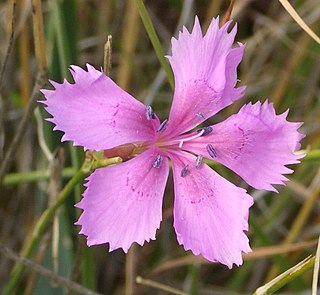
Dianthus is a genus of about 300 species of flowering plants in the family Caryophyllaceae, native mainly to Europe and Asia, with a few species extending south to north Africa, and one species in arctic North America. Common names include carnation, pink and sweet william.

Dianthus barbatus, the sweet William, is a species of flowering plant in the family Caryophyllaceae, native to southern Europe and parts of Asia. It has become a popular ornamental garden plant. It is a herbaceous biennial or short-lived perennial plant growing to 13–92 cm tall, with flowers in a dense cluster of up to 30 at the top of the stems. Each flower is 2–3 cm diameter with five petals displaying serrated edges. Wild plants produce red flowers with a white base, but colours in cultivars range from white, pink, red, and purple to variegated patterns. The exact origin of its English common name is unknown but first appears in 1596 in botanist John Gerard's garden catalogue. The flowers are edible and may have medicinal properties. Sweet William attracts bees, birds, and butterflies.

Dianthus deltoides, the maiden pink, is a species of Dianthus native to most of Europe and western Asia. It can also be found in many parts of North America, where it is an introduced species.

The Award of Garden Merit (AGM) is a long-established annual award for plants by the British Royal Horticultural Society (RHS). It is based on assessment of the plants' performance under UK growing conditions.
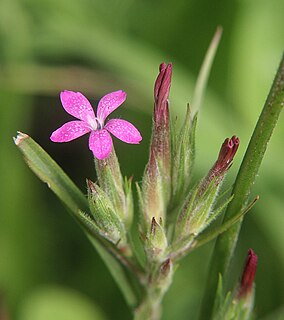
Dianthus armeria, the Deptford pink or grass pink, is a species of Dianthus ("pink") native to most of Europe, from Portugal north to southern Scotland and southern Finland, and east to Ukraine and the Caucasus. It is naturalised in North America.

Dianthus gratianopolitanus, commonly known as the Cheddar pink, is a species of plant in the family Caryophyllaceae. It is a herbaceous perennial, hardy to zones 4–8. It grows to a height of 0.5 to 1 feet, blooming from May to June. Flowers are fragrant and rose pink. Grows best in full sun, and has medium water requirements. Overwatering or poor drainage leads to crown rot, and plants do not tolerate wet winter soil conditions.

Dianthus alpinus, the alpine pink, is a species of flowering plant in the family Caryophyllaceae, endemic to the Alps of Eastern Austria. It is a short mat-forming herbaceous perennial, with linear to lanceolate leaves, 15–25 mm long and 2–5 mm wide. The flowers are a deep cerise pink with white spots, appearing from June to August.

HMS Dianthus was a Flower-class corvette of the Royal Navy. She was launched on 9 July 1940 from the Leith Docks on the Firth of Forth and named after the genus of flowering plants including Carnation, Pink, and Sweet William. The ship escorted trade convoys between Newfoundland and the Western Approaches through the Battle of the Atlantic wolf pack attacks of the winter of 1942–43.
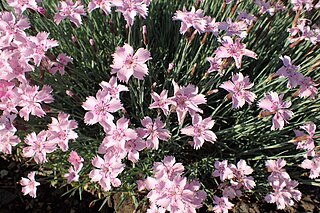
Dianthus plumarius, also known as the common pink, garden pink, or wild pink, is a species of pink-coloured flower in the family Caryophyllaceae.
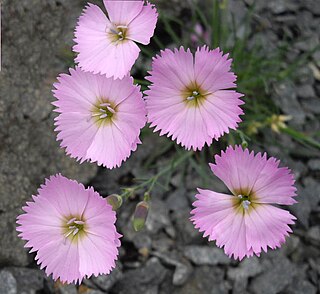
Dianthus sylvestris, the wood pink, is a species of Dianthus found in Europe, particularly in the Alps, and also said to be disjunctly found in the mountains of Greece. A perennial, it prefers to grow in drier, stony places, so it is occasionally planted in rock gardens.
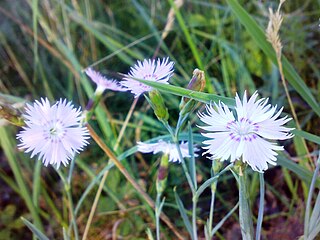
Dianthus arenarius, the sand pink, is a species of Dianthus typically found on the shores of the Baltic Sea, although there are populations elsewhere in colder areas of Europe where there are sandy soils. The unimproved species, and at least one cultivar, 'Little Maiden', are available from commercial suppliers.

Dianthus acicularis is a species of pink in the carnation family mostly found in the Urals region; eastern European Russia and western Siberia, with some occurrences in Kazakhstan, and Xinjiang in China. A diploid, its resistance to bacterial wilt of carnation and ease of cell line propagation in the laboratory make it useful for breeding ornamental carnations for the cut flower industry.
Dianthus orientalis, called the Georgian pink, is a species of pink in the carnation family found in the Levant, Anatolia, the Transcaucasus and the North Caucasus, Iraq and Iran, and disjunctly in Tibet and Xinjiang in China. Given its preference for drier, rocky and alkaline soils, and its attractive lilac‑pink flowers which appear in autumn, it is being studied as a potential ornamental plant, and for use on green roofs.

Dianthus crinitus is a species of Dianthus in the carnation family found in northwestern Africa, the eastern Aegean Islands, Anatolia, the Transcaucasus and the North Caucasus, Lebanon, Syria, Iran, the Gulf States, and Oman. Common names may be associated more with some subspecies than others, and include hairy carnation and long‑haired pink. It grows on serpentine soils.

Dianthus broteri is a species of Dianthus in the carnation family native to the Iberian peninsula, preferring to grow close to the coasts. Dianthus broteri is a complex of polyploid races, with 2n=2x=30, 2n=4x=60, 2n=6x=90 and 2n=12x=180 chromosomes detected in different populations, the largest polyploid series in the genus.

Dianthus borbasii is a species of Dianthus in the carnation family native to the steppes and light pine woodlands of Eastern Europe and western Asia as far as Kazakhstan. They prefer to grow in sandier soils, or places with light disturbance, so that there is less competition from grasses.

Dianthus giganteus, the giant pink, is a species of pink native to Romania, the Balkan peninsula and possibly nearby areas. A perennial reaching 1 m, it is useful in gardening and landscaping applications where a backdrop of taller plants is needed. It is available from commercial suppliers. The Royal Horticultural Society considers it to be a good plant to attract pollinators.


















